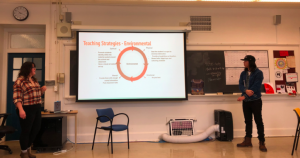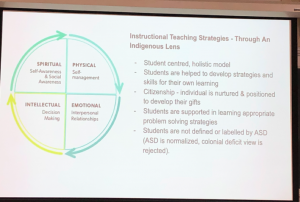
Students in the Waaban cohort of Ixchel Bennett’s “Inclusion, Disability and Education” course had the opportunity to research various exceptionalities through an Indigenous lens. The students referred to their own Indigenous teachings and to Dr. Pamela Toulouse article: What Matters In Indigenous Education: Implementing a Vision Committed to Holism, Diversity and Engagement.
As the students were conducting their research, they were asked to critically analyze the terminology used to describe each exceptionality by the Ministry of Education and other medical organizations. The guiding questions that they followed were:
- How are we meeting the spiritual, emotional, mental, and physical needs of special education students?
- How are we critically analyzing the language we use to describe special education students?
- What are teachers’ attitudes toward special education students?
Students Johannah Brown and Jennifer Hunter presented on the exceptionality Deaf and Hard of Hearing. “Many of the resources for Deaf and Hard of Hearing students on the Ontario College of Teachers website are not up to date,” said Brown. “We also noticed that the Ministry of Education does not use the definition of deafness that the Deaf Community has put forth. Rather than seeing deafness as an impairment, the cultural model of deafness focuses on the shared language and culture of the Deaf community.”
Brown and Hunter chose to focus on this definition because they believe that self-determination is one of the most important things when working with any community. Connected to this is the importance of forming relationships with Deaf students and their families. Relationships are fundamental to making sure students feel safe and included in the classroom

The students noted preferred teaching strategies included on the Ontario Teachers Federation’s special education website, and found the Special Education in Ontario, Kindergarten to Grade 12: Policy and Resource Guide very helpful. Jamie McIntyre, a student in the Waaban cohort shared, “If we relate the recommended teaching strategies in these resources to our four-directions worldview, where the physical, emotional, mental and spiritual well-being of students are considered, there is a special emphasis on mental and physical interventions.”
As students were researching resources, they paid close attention to community organizations that focused on supporting First Nations, Métis and Inuit parents/guardians. One organization was the Child and Parent Resource Institute. Students Julia Hill and Amber Smith chose this organization because they focus on providing services to First Nations, Inuit and Métis children and families in culturally sensitive and culturally safe ways.
Indigenous worldviews believe that every child has a gift to offer to the world. It is the role and responsibility of teachers to highlight each student’s gifts. As well, holistic education serves all students because it meets the physical, emotional, mental and spiritual well-being of students.
